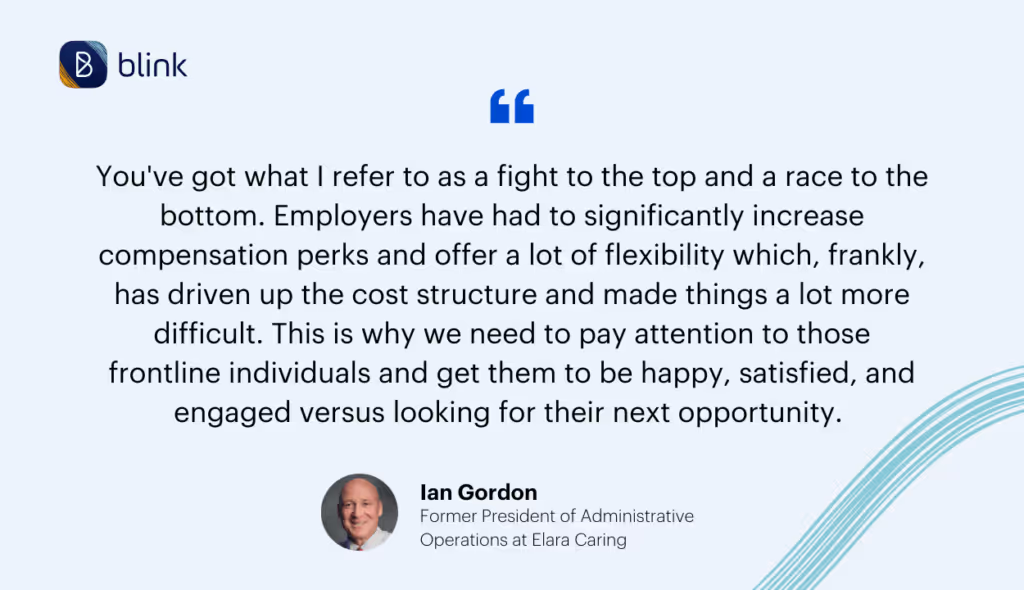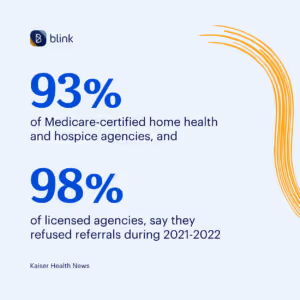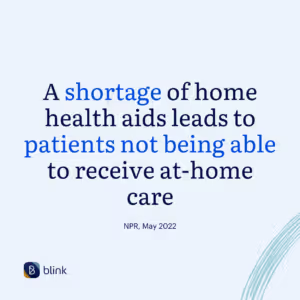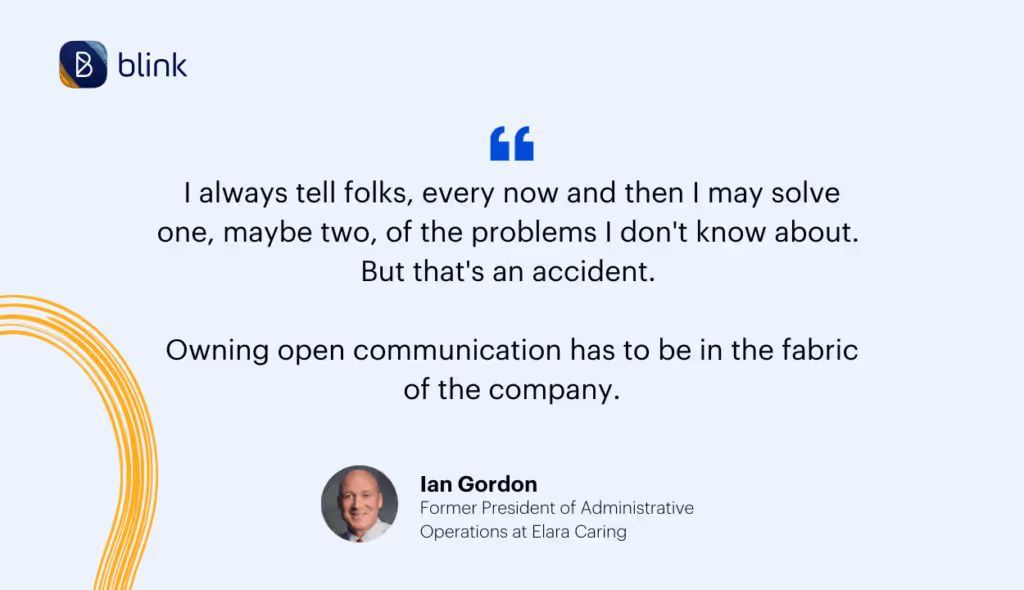Ian Gordon has worked in the US healthcare space for close to 30 years and has held executive roles in several large payer and provider organizations — most recently, as President of Administrative Operations at Elara Caring.
Throughout his career, he has also led large frontline organizations and created environments where employees thrived, and customers were highly satisfied. As a result of his experiences, few people can speak to the healthcare frontline engagement challenge as well as Ian.
Blink and Ian sat down together for a February 2023 webinar, discussing topics including company culture, senior leadership engagement, digital transformation, and the opportunity to boost engagement, loyalty, and retention with frontline employees.
Listen to the full webinar conversation ‘Why Engaging With Frontline Healthcare Workers Makes Both Dollars and Sense’ here or keep reading for the main discussion points.

Speakers:
- Ian Gordon, Former President of Administrative Operations at Elara Caring
- Marcy Paterson, Head of Solutions Consulting, Blink
How would you summarize the frontline engagement challenge organizations face in 2023?
The first point to make is that frontline disengagement is not a new challenge. What is new, however, is how this challenge has risen to the top of the Executives’ problem list — and I think there are four main reasons why:
- Unprecedented disruption to the workforce
- Employee burnout and generational differences between older participants in the workforce, Millennials, and Gen Z: the rise of the “gig” mentality and younger workers’ drive for work/life balance
- Changing societal demographics and the desire for people to live independently and “age in place”
- And, crucially, the huge competition for workers. Employers have had to significantly increase compensation and offer more flexibility, which drives up the cost structure
What’s essential now is that we develop a more acute understanding of the implications of dissatisfaction among frontline employees: how it leads to employee turnover and what that means to our companies.
Because, if we’re honest, what we've tried in the past hasn't worked to create significant levels of employee satisfaction, engagement, and loyalty.
Frontline workers feel under-appreciated and under-supported and, as a result, that makes them less loyal and more likely to look for the next opportunity. You might have their hands on the job for now, but you haven’t got their hearts.

What are the impacts of disengagement?
I call it the quadruple miss. When frontline employees are disengaged, this has an:
- Impact on patients who experience high caregiver turnover and inconsistency of care; they simply don’t get the comfort they are looking for when aging in place
- Impact on patients’ families who step up to fill the gaps caused by interrupted care and must meet and re-brief caregivers on a regular basis. This can hurt them in their own personal and/or professional lives
- Impact on frontline workers who are the ones confronted by the family’s frustration. And, in instances of high attrition, new incoming frontline workers feel responsible for the family’s frustration, and they become frustrated as well
- Impact on the company who suffers in terms of resources spent on recruiting and training a revolving door of employees. Plus, the cost of reputational damage and lost annual revenue
Attrition is a huge issue, and a lot of money is being spent on recruitment to address those challenges. But is it a long-term losing proposition?
I use the analogy of a leaky bucket because turnover at the rates we’re seeing now — as high as 70% in some companies — has organizations in a panic. They need to bring on so many new frontline employees; they’re recruiting, hiring, and training teams, spending money on advertising, and investing in higher salaries.
And yet, they still can’t keep up with demand.
I saw a survey recently that claimed 85% of home health agencies had turned away business because they didn’t have the staff and almost 60% said they did this "consistently".


Long-term, this attrition issue becomes a self-fulfilling prophecy; if you use recruitment as your primary solution to a retention issue, you will never fix the root cause.
If recruitment isn’t the solution, what is? What have you seen work?
I think that leadership needs to acknowledge their contribution to the problem. As leaders, we are responsible for creating a supportive environment and we need to acknowledge that we’ve helped create the employee dissatisfaction and engagement problem we have today.
Then, you need to spend time with and listen to your frontline.
This needs to be managed authentically; it’s often not a frequently occurring event and so employees don’t feel comfortable openly and honestly engaging with executive leadership. Leaders go in with more of a (potentially scripted) corporate message, ready to tell the frontline what the corporation wants them to hear rather than what they really need to hear. That’s not going to move the dial for employees and encourage them to become more engaged.
Healthcare employee surveys are a step in the right direction. They are valuable and give you data at a point in time that you can trend. But what I’ve seen happen is that people spend more time debating the validity and accuracy of the survey. If you torture the numbers long enough, they’ll confess to anything, and people get caught up in that.
What we’re talking about here is bi-directional communication — who do you think should be responsible for that?
I think the answer is the same in every company: you need to find someone who has the energy, passion, and is empowered enough to lead the initiatives. That person could be the project lead, but preferably it’s someone from the frontline or with frontline experience. The frontline needs to have that relationship with management all the way up and be comfortable to share their concerns.
Communicating issues is a team effort. It starts with the CEO and runs the full way through to the frontline. Everybody has to own it.

Is there an opportunity to better engage that first line manager and leverage them?
The first line manager might just be the hardest worked and most undervalued level of management in any company. They have passion and commitment and do everything they can, but if you look at the amount of administrative work that’s burdened on top of them — in addition to what they should be doing already — it’s tremendous. They barely have any time to try to manage their teams.
And yet we do need to engage them. They are the closest to the frontline and so if you’re not getting everything you need from the frontline or hearing what you need to hear, these are the people who know them best. Often, they’ve done the job; they’ve experienced the challenges first-hand.
But before we can engage them, we need to make sure that they’re okay. We need to understand what’s helping them be engaged or causing them to be disengaged in their jobs. It’s impossible to ask somebody to help drive engagement, satisfaction, and loyalty when they don’t feel those things to the company themselves.
You mention the administrative burden. The same digital transformation that desk-based workers get is yet to reach the frontline. How have you tried to alleviate that?
You need to understand the experience of having to perform repetitive mundane tasks. You need to go through that process yourself to discover what a horrible use of their time it is and why it’s no surprise that it doesn’t excite them each morning.
Then, you can look at how technology can be leveraged to simplify these tasks. It’s about taking away the administrative tasks that aren’t exciting, aren’t adding value, or aren’t rewarding for the employee so that people can be more satisfied and engaged.
If you can do that, then the quality of their work will go up and human errors will go down.
That’s what Blink really brings to the table. Using Blink, we were able to simplify our internal communication. We also gave frontline workers the tools to create communities, have single sign-on, and one place for information (versus the 5 or 10 that many nurses experience).
I’ve yet to meet a clinician or caregiver who got into this line of work to be on a computer all day. If we can reduce this non-cognitive load, then we can give them back the time they need to improve patient care.
How do you look to create a return on investment from these programs? Where have you seen that return and how have you been able to qualify it?
Administrative savings are easy to qualify. You know the jobs that people do, and if you can eliminate tasks and enable them to get more done in less time, then it's easy to say I need fewer people, or the same number of people can take on more work.
But the investment you need to make won’t pay for itself with administrative savings alone. That’s when you look to the impact on turnover — loyalty, satisfaction, and engagement — to make frontline workers more productive.
And when turnover declines, then that's tremendous because of the amount of savings that can be reaped from reducing the spend that companies have poured into their HR: recruiting, hiring, and training.
If you can redeploy those training resources to the frontline instead, giving them the skills and capabilities to enhance their service, then that can be a differentiator in the marketplace. It is also a good reason for your frontline to feel appreciated and invested in.
What are the pitfalls you’ve seen in organizations embarking on initiatives like this?
One would be rushing head-first into a solution before you truly understand the problem. You need to take the time to learn what’s important to different people in different positions.
Then there’s having a lack of clear direction or rapidly changing direction. It’s better to follow through on fewer, more meaningful activities. When employees don’t see the follow through, they become numb to the activities and disengage at another level.
And lastly, talking at employees instead of with employees.
How important is it to create a simplified experience specifically for the frontline?
Many organizations are comfortable with solutions for tethered employees — those who are in the office or working at a desk all the time, with access to a community of help.
But being a frontline worker can feel like you're on an island by yourself, and the solutions that you need must be quicker and more succinct. You can't spend a lot of time signing in and navigating. You need to get to your answer now.
You may be doing it while you're in front of a patient or, in the in the case of home health, while in between patients. Either way, you haven’t got a lot of time, and so having hub-based access to all-inclusive and easy-to-navigate information can really be a benefit to employees.
As leaders, the question we need to ask ourselves is this. Are more worried about playing it safe and trying to protect our jobs, at least in the short term, or are we willing to do what’s right for our employees and our customers: ensuring we create an environment where customers can be satisfied and employees can feel trusted, respected, and appreciated?
Blink. And your frontline workers feel connected.
Blink is the world’s best app for frontline workers, proven to lower frontline attrition by up to 26% and increase frontline employee engagement.
Learn more by booking a demo today.

